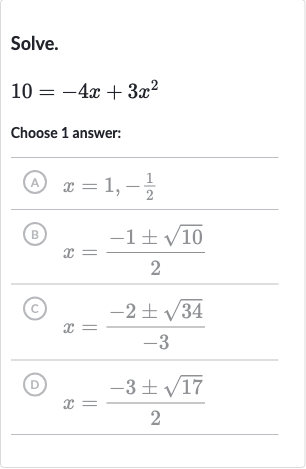AI tutor
Full solution
Q. Solve.Choose answer:(A) (B) (C) (D)
- Rewrite equation in standard form: Rewrite the equation in standard quadratic form, .We have . To rewrite it, we move all terms to one side to get .
- Identify coefficients: Identify the coefficients , , and from the standard form.Comparing with , we get:
- Substitute values into quadratic formula: Substitute the values of , , and into the quadratic formula .Substitute , , and into the formula.
- Simplify expression under square root: Simplify the expression under the square root and the constants outside the square root.
- Factor out common factor in numerator: Simplify the expression further by factoring out the common factor in the numerator.Since and have a common factor of , we can simplify the fraction by dividing both the numerator and the denominator by .
- Two possible solutions for x: Now we have two possible solutions for x.x = or x = These solutions can be further simplified to:x = or x =
- Compare solutions with answer choices: Compare the solutions with the given answer choices.The solutions we have are in the form , which is not immediately recognizable in the answer choices. However, we can simplify to to see if it matches any of the choices.This matches answer choice (C) .
More problems from Solve a quadratic equation using the quadratic formula
QuestionGet tutor help
QuestionGet tutor help
QuestionGet tutor help
QuestionGet tutor help
QuestionGet tutor help
QuestionGet tutor help
QuestionGet tutor help
QuestionGet tutor help

